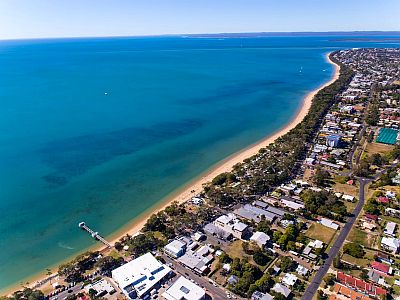Select units of measurement for the temperature and rainfall tables (metric or imperial).
Average weather, temperature, rainfall, sunshine hours

The climate of Hervey Bay is
humid subtropical, with very mild, relatively dry winters (from June to August) and hot, rainy summers (from December to March). Being in the southern hemisphere, the seasons are reversed compared to the northern hemisphere.
The city is located on the east coast of Australia, just south of the Tropic of Capricorn in Queensland, north of Brisbane and the Sunshine Coast. The bay from which the city takes its name is closed to the east by
Fraser Island (also known as K'gari), a UNESCO World Heritage Site.

Winter, from June to August, is very mild, however,
cold air can sometimes arrive from the south and lower the temperature, especially at night, when it can drop below 5 °C (41 °F). In June 2007 it dropped to -1.2 °C (29.8 °F).
In summer, with the prevailing wind from the ocean, it is above all the humidity that is felt, sometimes, however, there can be very hot days, with highs around 35 °C (95 °F).
This area can be affected by
tropical cyclones, although somewhat less often than in the part of Queensland north of the Tropic. Furthermore, Fraser Island partially protects the city from the direct impact of cyclones. Cyclones typically form from mid-November to mid-May, but are more likely from January to March.
Best Time
Given that it has a good climate, you can visit Hervey Bay all year round. However, you can choose winter and early spring, ie
from June to September, since it is the mildest and driest time of the year.
Summer is hot and muggy, but the heat is generally bearable, and it's a good period for swimming and sunbathing; sometimes, however, there can be severe thunderstorms, and even a cyclone can approach the city.
For
swimming, from July to September the sea is a little cool, and at times, as we have said, the air too can get a bit cold, so you may prefer the months of October and November, which are still not rainy like the summer ones.
Hervey Bay - Climate data
In Hervey Bay, the
average temperature of the coldest month (July) is of
16 °C, that of the warmest month (January) is of
26.2 °C. Here are the average temperatures.
Hervey Bay - Average temperatures (1999-2020) |
| Month | Min | Max | Mean |
|---|
| January | 22 | 30.3 | 26.2 |
|---|
| February | 22 | 30.2 | 26.1 |
|---|
| March | 20.7 | 29.1 | 24.9 |
|---|
| April | 17.8 | 27.1 | 22.5 |
|---|
| May | 14.1 | 24.3 | 19.2 |
|---|
| June | 11.9 | 22.1 | 17 |
|---|
| July | 10 | 21.9 | 16 |
|---|
| August | 10.4 | 22.9 | 16.6 |
|---|
| September | 13.9 | 25 | 19.4 |
|---|
| October | 16.9 | 26.6 | 21.8 |
|---|
| November | 19.1 | 28.2 | 23.6 |
|---|
| December | 21 | 29.5 | 25.2 |
|---|
| Year | 16.6 | 26.4 | 21.45 |
|---|
amounts to
1030 millimeters per year: it is therefore quite abundant. It ranges from
35 millimeters in the driest month (September) to
135 millimeters in the wettest ones (February, March) Here is the average precipitation.
Hervey Bay - Average precipitation| Month | Days |
|---|
| January | 125 | 8 |
|---|
| February | 135 | 9 |
|---|
| March | 135 | 11 |
|---|
| April | 65 | 9 |
|---|
| May | 90 | 10 |
|---|
| June | 75 | 8 |
|---|
| July | 40 | 5 |
|---|
| August | 50 | 4 |
|---|
| September | 35 | 4 |
|---|
| October | 80 | 5 |
|---|
| November | 75 | 6 |
|---|
| December | 120 | 8 |
|---|
| Year | 1030 | 88 |
|---|
The
sea temperature ranges from
21.5 °C in August to
27 °C in February. Here are the average sea temperatures.
Hervey Bay - Sea temperature| Month |
|---|
| January | 26.5 |
|---|
| February | 27 |
|---|
| March | 26.5 |
|---|
| April | 25.5 |
|---|
| May | 24 |
|---|
| June | 23 |
|---|
| July | 22 |
|---|
| August | 21.5 |
|---|
| September | 22 |
|---|
| October | 23 |
|---|
| November | 24.5"> |
|---|
| December | 25.5 |
|---|
| Year | 24.2 |
|---|